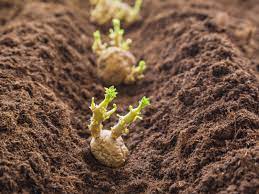
Planting potatoes is not a simple thing; you have to do certain procedures to plant your potatoes. If you want to get better results you have to be more patient. Because the potatoes need more time to grow. Just follow the procedure to grow quality organic potatoes.
Step 1: Choose Seed Potatoes
Start with certified disease-free organic seed potatoes from a farm store or catalog. (Spuds from grocery stores that have been treated with a sprout-retardant shouldn’t be planted.) If, like me, you purchase from a farm store, make an effort to choose tubers that have already sprouted. If not, just spread them out on your kitchen surface to start the sprouting process. Potatoes that have been sprouted can be harvested a few weeks sooner than their non-sprouted counterparts.
Step 2: Separate the Eyes
Plant just entire potatoes, no bigger than a golf ball. Slice big tubers into little pieces. I chopped mine such that every section had two or three “eyes”—those little protuberances from which seedlings protrude—as seen in the picture. The potatoes are being trimmed because too many eyes on one huge potato will result in a crowded, multi-stemmed plant that will eventually yield only little potatoes as each stem competes with the others for nutrients and moisture.
Step 3: Cure the Cut Pieces
Let the sliced pieces “cure” next. For three to five days, either leave them out in the sun or put them on a table or counter in a warm (approximately 70°F), fairly light environment. This process allows the wounds to calluses. Rugged seed potatoes can help keep them from rotting.
Step 4: How & When to start Planting Potatoes
How deep when do you plant potatoes? Place the cut-side-down (eyes up) seed potato pieces in a 6-inch-deep trench or hole. On all sides, give each segment a 12-inch space.
Apply two teaspoons of a low-nitrogen, high-phosphorous fertilizer in between each section. Next, add two inches of dirt to cover the fertilizer and potatoes, and make sure the soil is well-watered.
When should potatoes be planted? Warm-weather gardeners typically plant around Valentine’s Day, but cooler-weather gardeners could plant around Easter or in the early spring. Aim for three to four weeks before your final frost date as a general rule of thumb.
Step 5: Hill around the Stems
It’s essential to “hill” the vines so new potatoes grow on lateral stems, or “stolons,” above the seed potato. Once the green sprouts are eight inches tall, cover everything except the top four inches with dirt, and leaves that have been cut, or shredded. After the potato plants develop a further 8 inches, hill again. Your crop will probably be more plentiful the more hills you make. Usually, I hill mine up to eighteen inches. Hilling should cease after the vines blossom.
Similar to vampires, potato tubers must dwell in the dark. Light will cause them to become green. Furthermore, eating a green potato might make you sick. Thus, the tubers must always be covered with mulch or dirt.
Step 6: How & when you can Harvest Potatoes
After the vines have bloomed for two weeks, you can, if you’d like, reach down into the mulch or dirt and pull a few young potatoes out. If not, bide your time till the vines wither away. The tubers are mature when dead vines appear. Now insert your hands into the ground and lift the tubers out.
How long do potatoes take to grow? As early as 10 weeks might bring the maturity of little young potatoes. On the other hand, it takes 80–100 days for full-sized potatoes to mature.
Step 7: Store Your Potatoes
You must leave your potatoes in the ground until the weather turns chilly since they are cultivated for storage. How come? For potatoes to keep well, they need to be kept in a chilly environment that does not freeze. Your mudroom closet doesn’t become cold until it gets down to forty-five degrees outside at night. That means that a sunny day in late October is harvest time for you.
The tubers are left to dry for a few hours on top of the raised beds once they have been dug. Their skin becomes tougher over this short drying time, readying them for preservation. After that, you carefully brush the tubers clean of any loose dirt and put them in paper bags that are twice as thick.
How to Plant potatoes in bags or containers is your biggest question. The answer is simple just follow the above procedure. Compared to planting potatoes in a garden this option is very easy. Enjoy the gastronomic experiences of our Liturgical Temples food blog. Discover recipes, culinary techniques, and world cuisines.